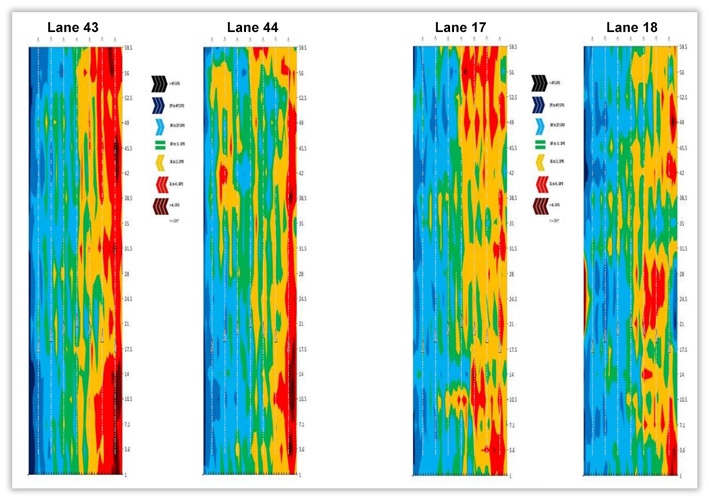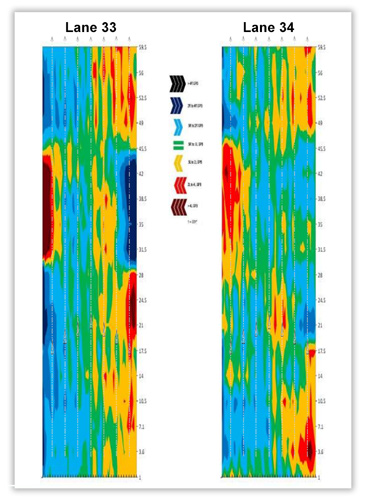Having just finished bowling in the 2019 USBC Open Championships, I thought it might be helpful to share my experiences. However, I’d like to start with a few important disclaimers:
- I was only able to bowl twice in the month leading up to traveling to Las Vegas to bowl in this event. Both were three-game league sessions. This is not exactly the preparation I’d recommend for people trying to make the most of their tournament experience.
- I also arrived in Las Vegas with only one bowling ball. This is obviously not the arsenal of a competitive bowler. On the bright side, though, a teammate had drilled me a ball and brought it down with him. This doubled the size of my arsenal, but my first use of the new ball came during team event. Again, this is not exactly the type of preparation I’d recommend.
- This was my first tournament as a bowler in about 10 years. I was more excited and nervous than I expected to be, and it took some time to settle in. Even as a coach who has helped countless bowlers through these emotions, there is just no substitute for competition reps (i.e. tournament experience) when it comes to getting comfortable quickly at an event like this.
With these disclaimers in mind, let’s take a look at what you might expect from this year’s tournament, through the eyes of a coach bowling in his first tournament in a decade. We’ll talk about the equipment I used (and what I’d recommend bringing), the general topography of the South Point Bowling Plaza, and my thoughts on this year’s oil patterns.
Topography
I bowled my team event on lanes 43 and 44 and my doubles and singles events on lanes 17 and 18. I believe these two pairs are pretty typical of most pairs at South Point: there are minor differences that could affect your moves on each lane, but for the most part, they are similar enough to not necessitate major differences in lane play.

Topography maps of my two pairs: 43 and 44 (left) for team event, and 17 and 18 (right) for doubles and singles. A full set of topography maps for all lanes in the South Point Bowling Plaza has been provided by the USBC and is available here.
As you can see, lanes 43 and 44 are very similar, with only minor variations overall, and a slightly tighter-looking (i.e. less hooking) topography for lane 44. Based on this lane map, I wasn’t expecting the lanes on this pair to play more than a board different. It’s easy to overestimate the impact of the colors on the lane map and forget to consider their location. On a short pattern that would require us to play outside of the 5 board, lane 43 would have hooked significantly more and earlier than lane 44. But, for a medium-length pattern, where we’d likely be inside the 5 board the entire time, the topography only had slight differences. Depending on a bowler’s ability to repeat shots, the level of ball motion variation caused by this amount of difference in topography could get masked by their natural shot-to-shot variety. During team event, my moves for each lane were the same, by which I mean I never had to play one lane with a different line or a different ball.
Lanes 17 and 18, where we bowled our doubles and singles sets, are a different story. There’s an obvious hook spot for righthanders on lane 18 in the midlane, and we can see that the back ends are slightly stronger on lane 17. Overall, I expected these lanes to play about the same overall from a left-to-right point of view because of those offsetting hook spots, but possibly require a different ball on each lane to create the right shape front-to-back. Either that, or I suspected that the right lane would force us to move left faster. In this case, it turned out to be the latter. My moves on the left lane came after my moves on the right lane for doubles, but by the time I was left of that hook spot on lane 18 in singles, I was able to play these two lanes the same.
For those who are curious, if the different ball theory had proven true on lanes 17 and 18, I thought it was possible we’d need a smoother ball on 17 because of the stronger back ends, and a slightly cleaner, more angular ball on lane 18 due to the earlier hook spot and tighter back ends. As it turns out, I simply had to go to that smoother/cleaner ball (more on equipment later) about two frames earlier on lane 18, but that’s not a significant difference along the lines of using a different ball and line throughout the entire block.
From my prior coaching experience in the South Point Bowling Plaza—and looking again at the lane map this year—these two pairs are actually pretty typical: there are some pair-to-pair differences, but there are mostly minor variations within a single pair that will affect your decision-making. Except, that is, for lanes 33 and 34. This pair has a significantly different midlane look on on lane 33 compared to lane 34, and one that could very easily cause you to use a different strategy on each lane.

Topography maps of lanes 33 and 34. Again, please click here for the full set of topography maps supplied by the USBC for South Point Bowling Plaza.
While I didn’t hit this pair for the Open Championships, Team Canada did hit this pair in the first game of doubles at the World Mixed Championships in 2017. On that occasion, we actually employed a very different oil pattern breakdown strategy from normal. We actually tried to burn up the tight lane and carry the oil down with plastic on the hooking lane in order to make both lanes play more similarly. We felt that being able to play both lanes about the same would yield us the best results. And, in that case, our strategy worked: we were able to get off this tricky pair with a solid plus-score. Be sure to keep an eye out for this pair if you hit it, because you can expect there to be differences in how you’ll have to attack these lanes, particularly on the fresh when you are more likely to be close to that hang spot on lane 33.
Oil patterns
Team event
I was a little surprised by how much friction was on the lanes for the team event. With all the traffic a five-person team brings, I thought the lanes would have started a little tighter than they did. That said, it wasn’t overly dry, and the outsides definitely had an out-of-bounds. It felt like a shorter medium pattern in the 37-foot to 38-foot range, or even possibly a little bit longer than that with low volume.
Of course, that friction tends to be misleading for many bowlers. The instinct is to move left when the lanes hook more, but that’s not how fresh sport patterns work. Generally speaking, you play farther inside on long patterns, and farther out on short patterns. For some reason, that same friction that pushes you right on short patterns makes people want to move left on a medium pattern. However, keep in mind that it’s generally not a good idea to attack a pattern from the flattest part of it, which is usually the middle.
I didn’t bowl with a team that could break it down, or with a companion team to help us, but I believe this pattern is playable and will yield some good scores to teams smart enough to stay right at first and then jump left. With my coaching hat on, I’d advise teams to break it down up boards 3 through 5 at the arrows, and then move in to somewhere between 7 and 12 at the arrows, with a breakpoint of around 5 to 7, based on rev rates and preferences. The tricky part will be the transition left. It will likely be a sudden jump left with a drastic change in launch angles to be able to score, but jumping left too early will yield considerable over/under reaction. The timing of the move will be key. Breaking it down instead between the 5 board and 10 board is doable, but this will force your angles open quickly and probably won’t be as effective.
For lefthanders, most righties shouldn’t disturb your laydown point if you stay outside of 10, and there really wouldn’t be any need to jump inside unless there are multiple lefties on your pair. I’d recommend the same strategy of burning up the 3 to 5 boards, or maybe even farther outside than that if the pair yields that to you based on topography.
Doubles and singles
After seeing so much friction in the team event, I safely assumed that the doubles and singles pattern would play tighter. It definitely played longer and required a different strategy compared to the team event pattern. I felt like it was closer to the to the 41-foot to 42-foot range in length.
Assuming the lanes would be a little tighter, I asked the three doubles teams on my pair to not throw a ball left of 10 in practice. We didn’t have the talent on the pair to specifically burn a two or three board area, so I was happy as long as we left the area inside the 10 board fresh and kept our shots between 5 and 10 during practice. It worked well to create a bit of room right away, and we saw some pretty consistent transition throughout. This is what tends to happen when you break a lane down with straight angles.
I’d suggest a similar strategy for bowlers, keeping practice shots right of 10 (or picking a more defined area between 5 and 10), and using surface and stronger bowling balls to start the block. This strategy should yield consistent transition, where you can gradually move in and change balls as needed. I think this pattern will be more playable for higher rev rate players than the team pattern, due to the added hold, while lower rev rate players will probably be more comfortable on the team pattern.
A note for the left side: despite the longer feel to this pattern, the lefty on our pair found his best look with a urethane ball. If you have an above-average rev rate, keep that option in mind, without getting trapped into the default “reactive on longer patterns” mindset.
Equipment considerations
For the last several years, I’ve been a one-ball-bowler, bowling once a week in my league. This fall, I drilled an Ebonite Game Breaker 3. I planned to use this reactive solid as my fresh oil ball in Las Vegas, having it sanded to 500/3000 grit by hand.
The ball that arrived in Vegas to greet me was a freshly-drilled Storm IQ Tour, sanded at 3000 grit to a bit of a sheen. Some might immediately question my choice of two symmetrical solids, but this has always been the type of equipment I’m most comfortable with. From experience, after seeing dozens of high-end athletes throw it, I knew that the IQ Tour would be weaker than my Game Breaker 3, so it was meant as my complementary piece for transition.
Being brand new, I expected it to hook more left-to-right, but remember that “weaker” is best used as a description of how much oil the ball can handle effectively. Weaker balls often appear to “hook” more because of how they read the lane front-to-back, but they can be ineffective if there is too much oil volume up front.
Team event
On the fresh, you definitely want some surface. For higher rev rate, or high axis rotation angle players, urethane would likely be very useful. Balanced players would be fine with a mid-range sanded solid, and more speed-dominant bowlers could probably use an asymmetrical piece with slightly less surface. My Game Breaker 3 gave me decent control of the midlane once I committed to that strategy, playing around 11-to-7, although I probably would have benefited from a pin-down option, or possibly even urethane.
As the lanes transition, those capable of making the jump inside will want a weaker option that has a lot of back end hook, because the angles could become fairly steep. I was playing about 22-to-7 by the end of game three with my IQ Tour, and it probably could have even been slightly more sanded to blend the pattern a little bit better. For those who will need to stay straighter, you’ll still want to chase it left slightly, and an asymmetrical pearl with some sheen would be a good option for many people.
Avoid the temptation to use something too shiny. Something at 2000 or 3000 grit should give you enough clearance through the front and consistent reaction through the midlane and back end.
Doubles and singles
With this pattern tighter than the team pattern, most bowlers will need stronger balls for this event, and more surface—especially to start. This is where a stronger asymmetrical would fit nicely into the bag for most players, with only rev-dominant players potentially using a slightly weaker option. Only having my Game Breaker 3 as my fresh option, the real difference in lane play for me was taking hand out in team event, and using my full rev rate release to start doubles. With the way we broke down the pattern, I started with a line of around 12-to-8 and chased it in from there.
The stronger ball can probably stay in your hand longer for doubles and singles, but be ready to ball-down as the fronts burn up and you need your ball to retain more energy for the back end. The good news is that I found this pattern stabilized near the start of singles, and it even forced me back slightly to the right (which kind of fooled me), so you might find a similar experience where you can stop chasing left and park in a spot for significant time by the end of the six-game block. The odds are good that you’ll never need anything weaker than a mid-range pearl, unless you’re paired with an entire group of high rev rate players.
Ready to go!
I hope this sheds some light on what to expect this year at the USBC Open Championships. I’ve tried to give good general guidance that can apply to everyone, even though everyone’s experience will be different based on their lane play choices, preferences, and ability level. As usual, I feel like the USBC has done a good job of putting out patterns that players of all skill levels will find challenging, that will require an above-average performance for an above-average result.
For those interested, I battled my way to an 1810 all-events score for my nine games, which made me very happy given my preparation level and ability repeat shots on some very demanding conditions. Good luck to everyone heading to Vegas in the coming weeks and months!


